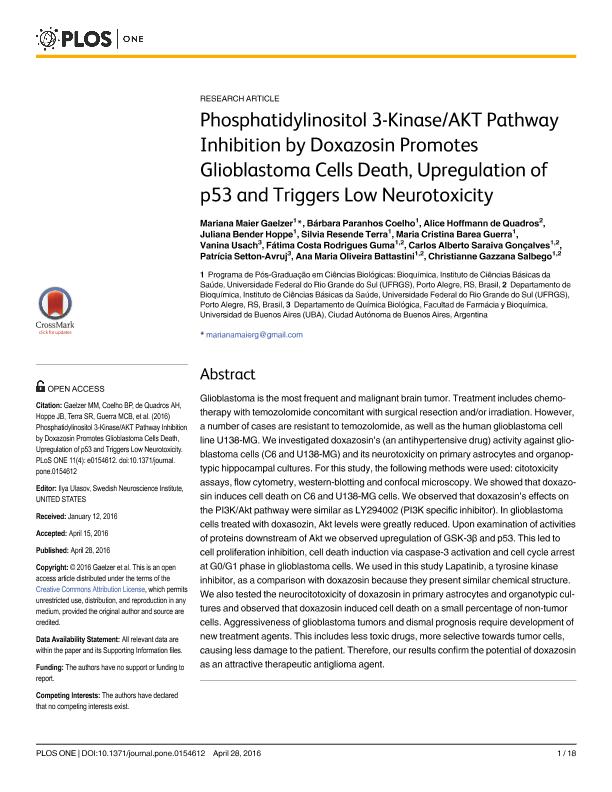Mostrar el registro sencillo del ítem
dc.contributor.author
Gaelzer, Mariana Maier
dc.contributor.author
Coelho, Bárbara Paranhos
dc.contributor.author
De Quadros, Alice Hoffmann
dc.contributor.author
Hoppe, Juliana Bender
dc.contributor.author
Terra, Silvia Resende
dc.contributor.author
Guerra, Maria Cristina Barea
dc.contributor.author
Usach, Vanina

dc.contributor.author
Guma, Fátima Costa Rodrigues
dc.contributor.author
Gonçalves, Carlos Alberto Saraiva
dc.contributor.author
Setton, Clara Patricia

dc.contributor.author
Battastini, Ana Maria Oliveira
dc.contributor.author
Salbego, Christianne Gazzana
dc.date.available
2018-03-20T18:56:27Z
dc.date.issued
2016-04
dc.identifier.citation
Gaelzer, Mariana Maier; Coelho, Bárbara Paranhos; De Quadros, Alice Hoffmann; Hoppe, Juliana Bender; Terra, Silvia Resende; et al.; Phosphatidylinositol 3-kinase/AKT pathway inhibition by doxazosin promotes glioblastoma cells death, upregulation of p53 and triggers low neurotoxicity; Public Library of Science; Plos One; 11; 4; 4-2016; 1-18; e0154612
dc.identifier.uri
http://hdl.handle.net/11336/39397
dc.description.abstract
Glioblastoma is the most frequent and malignant brain tumor. Treatment includes chemotherapy with temozolomide concomitant with surgical resection and/or irradiation. However, a number of cases are resistant to temozolomide, as well as the human glioblastoma cell line U138-MG. We investigated doxazosin's (an antihypertensive drug) activity against glioblastoma cells (C6 and U138-MG) and its neurotoxicity on primary astrocytes and organoptypic hippocampal cultures. For this study, the following methods were used: citotoxicity assays, flow cytometry, western-blotting and confocal microscopy. We showed that doxazosin induces cell death on C6 and U138-MG cells. We observed that doxazosin's effects on the PI3K/Akt pathway were similar as LY294002 (PI3K specific inhibitor). In glioblastoma cells treated with doxasozin, Akt levels were greatly reduced. Upon examination of activities of proteins downstream of Akt we observed upregulation of GSK-3β and p53. This led to cell proliferation inhibition, cell death induction via caspase-3 activation and cell cycle arrest at G0/G1 phase in glioblastoma cells. We used in this study Lapatinib, a tyrosine kinase inhibitor, as a comparison with doxazosin because they present similar chemical structure. We also tested the neurocitotoxicity of doxazosin in primary astrocytes and organotypic cultures and observed that doxazosin induced cell death on a small percentage of non-tumor cells. Aggressiveness of glioblastoma tumors and dismal prognosis require development of new treatment agents. This includes less toxic drugs, more selective towards tumor cells, causing less damage to the patient. Therefore, our results confirm the potential of doxazosin as an attractive therapeutic antiglioma agent.
dc.format
application/pdf
dc.language.iso
eng
dc.publisher
Public Library of Science

dc.rights
info:eu-repo/semantics/openAccess
dc.rights.uri
https://creativecommons.org/licenses/by-nc-sa/2.5/ar/
dc.subject
Pi3/Akt
dc.subject
Doxasonin
dc.subject
Glioblastoma
dc.subject.classification
Otras Ciencias Biológicas

dc.subject.classification
Ciencias Biológicas

dc.subject.classification
CIENCIAS NATURALES Y EXACTAS

dc.title
Phosphatidylinositol 3-kinase/AKT pathway inhibition by doxazosin promotes glioblastoma cells death, upregulation of p53 and triggers low neurotoxicity
dc.type
info:eu-repo/semantics/article
dc.type
info:ar-repo/semantics/artículo
dc.type
info:eu-repo/semantics/publishedVersion
dc.date.updated
2018-03-15T14:05:19Z
dc.identifier.eissn
1932-6203
dc.journal.volume
11
dc.journal.number
4
dc.journal.pagination
1-18; e0154612
dc.journal.pais
Estados Unidos

dc.journal.ciudad
San Francisco
dc.description.fil
Fil: Gaelzer, Mariana Maier. Universidade Federal Do Rio Grande Do Sul. Instituto de Ciencias Basicas Da Saude; Brasil
dc.description.fil
Fil: Coelho, Bárbara Paranhos. Universidade Federal Do Rio Grande Do Sul. Instituto de Ciencias Basicas Da Saude; Brasil
dc.description.fil
Fil: De Quadros, Alice Hoffmann. Universidade Federal Do Rio Grande Do Sul. Instituto de Ciências Básicas da Saúde. Departamento de Bioquímica; Brasil
dc.description.fil
Fil: Hoppe, Juliana Bender. Universidade Federal Do Rio Grande Do Sul. Instituto de Ciencias Basicas Da Saude; Brasil
dc.description.fil
Fil: Terra, Silvia Resende. Universidade Federal Do Rio Grande Do Sul. Instituto de Ciencias Basicas Da Saude; Brasil
dc.description.fil
Fil: Guerra, Maria Cristina Barea. Universidade Federal Do Rio Grande Do Sul. Instituto de Ciencias Basicas Da Saude; Brasil
dc.description.fil
Fil: Usach, Vanina. Universidad de Buenos Aires. Facultad de Ciencias Exactas y Naturales. Departamento de Química Biológica; Argentina. Consejo Nacional de Investigaciones Científicas y Técnicas; Argentina
dc.description.fil
Fil: Guma, Fátima Costa Rodrigues. Universidade Federal Do Rio Grande Do Sul. Instituto de Ciencias Basicas Da Saude; Brasil
dc.description.fil
Fil: Gonçalves, Carlos Alberto Saraiva. Universidade Federal Do Rio Grande Do Sul. Instituto de Ciencias Basicas Da Saude; Brasil
dc.description.fil
Fil: Setton, Clara Patricia. Universidad de Buenos Aires. Facultad de Ciencias Exactas y Naturales. Departamento de Química Biológica; Argentina. Consejo Nacional de Investigaciones Científicas y Técnicas; Argentina
dc.description.fil
Fil: Battastini, Ana Maria Oliveira. Universidade Federal Do Rio Grande Do Sul. Instituto de Ciencias Basicas Da Saude; Brasil
dc.description.fil
Fil: Salbego, Christianne Gazzana. Universidade Federal do Rio Grande do Sul; Brasil
dc.journal.title
Plos One

dc.relation.alternativeid
info:eu-repo/semantics/altIdentifier/doi/http://dx.doi.org/10.1371/journal.pone.0154612
dc.relation.alternativeid
info:eu-repo/semantics/altIdentifier/url/http://journals.plos.org/plosone/article?id=10.1371/journal.pone.0154612
Archivos asociados
